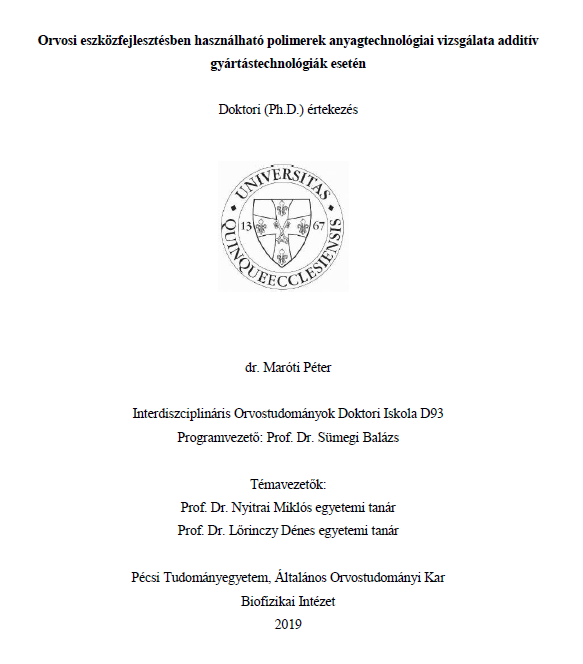Orvosi eszközfejlesztésben használható polimerek anyagtechnológiai vizsgálata additív gyártástechnológiák esetén
Abstract
Today additive manufacturing technologies (AM – Additive Manufacturing) are emerging in both fields of science and industry. Specifically, highly tuned 3D printing technologies can be found in common households, thanks to the rapid development of the technology and the remarkable corresponding IT solutions. Additive manufacturing bears a significant impact upon fundamental (e.g., material science) and applied areas of research (e.g., medical and clinical studies, industrial, mechanical and electrical applications). Most recent international studies have aptly demonstrated how 3D printing is the midst of an exploding, developmental era. The appearance of new materials and device manufacturing demands the scientific, critical evaluation of the technology, aligned with their practical implementation.
Despite the prominence of additive manufacturing in the field of emerging technologies dating from the 1980’s, it has gained immense international attention in the past decade. On a global scale, several research groups worked towards a solution not to ‘remove’ (e.g., CNC – computer numerical control) the material from the initial object, but to ‘add’ to it, therefore the manufactured object is built up in numerous layers, reducing material loss, saving time and costs. The first successful patent was filed by Charles Hull in the United States in 1984 in support of the process defined as SLA (SLA – stereolitography apparatus), in which the material was liquid-state photopolymer and hardened through the use of UV light. The first commercially available 3D printers operated very much the same as in the case of the 3D Systems, model SLA-1, 1987. In 1989, SLA 3D printers first appeared in Japan (products of NTT Data CMET and Sony/DMEC) and shortly afterwards followed by the German business entity, EOS (EOS - Electro Optical Systems). Several years later, in 1991, three new technologies appeared on the market, the filament-based Fused Deposit Modelling (FDM™), the ‘solid-ground-curing’ (SGC, Cubital), which is similar to SLA and the ‘laminated-object-manufacturing’ (LOM, by Helisys), in which a laser cuts out the structure from layers positioned on the top of one another. The next important milestone was the appearance of SLS (SLS – selective laser sintering) in 1992, which was the proprietary of DTM, and currently known as 3D Systems. The polymer powder based technology initiated the development of DMLS (DMLS – Direct Metal Laser sintering by Fraunhofer Institute, ILT, from Germany), which used metal powders as its material source. Both technologies are deemed relevant in both industrial and medical applications. The widening dispersion regarding 3D printing technology burst onto the scene in the middle of the 1990s when several manufacturers lowered the retail price regarding 3D print consumer goods. A superb example was the model Z402 inkjet 3D printer, which was the product of Z. Corp, or the paper-based 3D printer, which originated from Schroff Development, and featured a retail cost under $10,000.
Up through the middle of the 2000s retail costs underwent a consistent decrease making the new technology more affordable, and the trend was coupled with an increase in product solutions and development. Today 3D printers are available to the general public for a few hundred dollars and are marketed in the form of household use. These desktop devices are referred to as FFF (FFF – Fused Filament Fabrication), such as in the model RepRap. The fall in retail costs obviously served as an immense impact regarding professional use, particularly in the applications of medical research and industrial manufacturing. Thanks to the academic and market-based start-up business entities, not only did FFF, DLP and SLA solutions undergo a substantial drop in retail costs, the availability of industrial scale devices soared.

